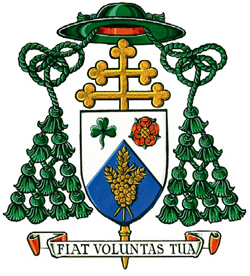Homily
[Sirach 44: 1, 8-13; Psalm 149; Mark 11:11-25]
Nearly one year ago, Pope Francis visited this very Sacred Heart Church of the First Peoples. In his discourse, he drew attention to the base of the church’s altar, which had been constructed and consecrated as part of the renovations necessitated by the fire. As you can see, the base is part of a tree, in relation to which the Holy Father said this: “Joined to the earth by its roots, a tree gives oxygen through its leaves and nourishes us by its fruit. It is impressive to see how the symbolism of the tree is reflected in the architecture of this church, where a tree trunk symbolically unites the earth below and the altar on which Jesus reconciles us in the Eucharist…” Behind these words of the Pope is the wondrous fact that the death of Jesus on the Cross transformed that instrument of savage torture into the tree of life, rooted in the infinite depths of God’s love and bearing fruit in the reconciliation of God with humanity and members of the human race with each other. What happened on that tree is rendered present on the altar of the mass, so that in the Eucharist we may be rooted deeply in the saving love of God and bear fruit in communion with one another. The Eucharist unites us to the tree of life and nourishes us with the grace we need to walk together.
In the Gospel text for this mass, we hear about a different tree. We are told that Jesus has just entered Jerusalem, soon to endure the Cross. A short time afterward, he sees a fig tree. In the words and actions that follow, Jesus prepares his followers to receive the grace of reconciliation that he would soon pour forth upon the world through his death on the tree of life.
The Lord mysteriously curses the fig tree for having no figs on it. I say “mysteriously” because, as Saint Mark himself notes, “it was not the season for figs”. Jesus would have known that, so he must be intending something particular by his words. In point of fact, while we know that the people of Israel are often compared in the Old Testament to a vineyard, there are also passages where the comparison is made rather to a fig tree. The point in each comparison is that God expects his people to produce the good fruit of righteousness by obedience to His commands. Jesus’s search for figs recalls this, and his curse of the tree expresses his deep grief at the lack of covenant fidelity he is encountering among his fellow Israelites.
Powerfully symbolic of the failure of the people to produce the fruit expected by God is their desecration of the Temple – the most sacred place of worship – by commercial activity motivated not by piety but greed. Jesus will have not of it, and drives out the sellers and moneychangers.
In these words and actions of Jesus, he is indicating that, in order for his followers to receive the grace of reconciliation soon to emanate from the Cross, they would need to call to mind God’s expectations and examine closely how they are falling short. From this would follow awareness of the need for purification of all that is not worthy of their status as God’s people, a cleansing that only Jesus could bring about.
How do we receive this, especially tonight as we gather around the altar, from which that same grace of the Cross will spring? What does it say to us who desire earnestly to walk together, something that only the self-offering of Jesus on the tree of life can make possible?
From the Gospel text, we can say that reception of divine healing and reconciling grace begins with acknowledging that God does have expectations of us as disciples of his Son. Like our forebears, recounted in the passage from Sirach, we, too, are to live godly lives, obedient to the Lord and expressing our faith in both worship and good deeds. When we fall short, we are to call upon Christ to cleanse by his mercy the temple that each of us is in virtue of our Baptism.
So, we do well to ask, in regard first of all to the “temple” of our individual lives: what is there that should not be? What of the “world” have I allowed into this space made holy by God’s indwelling? Are there feelings or attitudes that do not belong? Is the mind set on things not worthy of our Christian dignity? If we were to consider also the “temple” that is the Church, what is there that should not be? Whenever there are things present not in keeping with our Catholic identity, we need to acknowledge them in honesty, and in humility and repentance ask the Lord to cleanse the temple, not by whips and cords but mercy and forgiveness. Only by the cleansing power of his love can we be healed of all that separates us from Christ and each other, and thus enabled truly to walk together as members of a reconciled community.
Thankfully, what is present in the temple, and needs to be, is the CWL. You live from the commitment to walk together as members of this wonderful and necessary organization, and to walk with your Bishops, priests, and all other members of the Church in service of the Gospel. You understand well that to be “Catholic and living it” means walking together in the communion of faith. Thank you for your witness. As we now turn to the altar, the base of which points to the wondrous mystery that unfolds upon it, may the grace of the Eucharist strengthen our unity in Christ and impel us ever onward along the pathway of healing and reconciliation.
Most Reverend Richard W. Smith
Sacred Heart Church of the First Peoples, Edmonton
June 2nd, 2023

